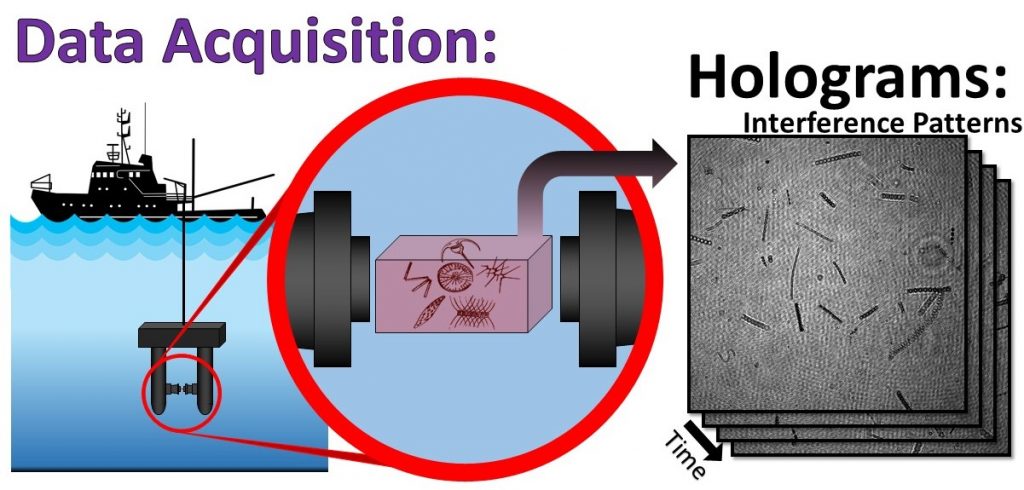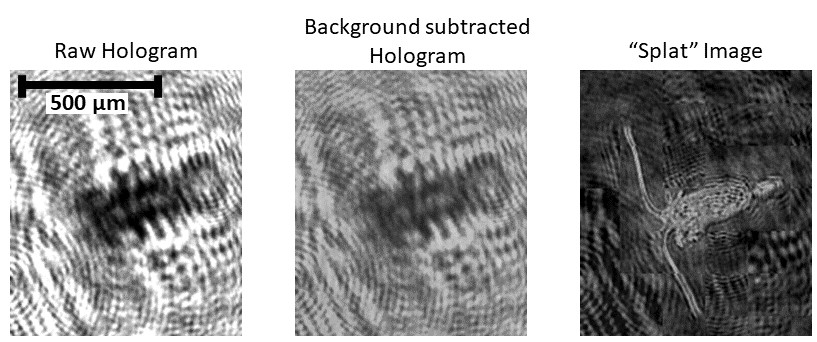During several cruises, we deployed our submersible holographic imaging system (HOLOCAM), which can sample at depths up to 300 m. HOLOCAM employs a 660 nm Nd-YAG red laser as the source of coherent illumination. The HOLOCAM can be deployed by itself or in tandem with other instruments. For field measurements, the HOLOCAM is slowly hand-lowered from an anchored ship into the water column at a rate of 4-6 cm/s, recording during both descent and ascent. What makes the HOLOCAM unique is its ability to acquire imagery of organisms in their undisturbed natural environment on initial descent. Imagery collected during the ascent is acquired in water that has been perturbed by the HOLOCAM’s descent, and thus allows for comparisons of biophysical interactions in both disturbed and undisturbed conditions.
 Our HOLOCAM acquires thousands of images per minute, each for a particular volume of water. Each organism/particle is at a different distance from the focal plane and therefore not all particles are in focus. These images must then be extensively processed in order for all the organisms in the image to be clear enough to be identified by an expert. First, in order to eliminate nonuniformities in the raw image and highlight the identified particles, a background-subtracted hologram is produced by subtracting the time-averaged hologram background from each individual hologram. From there, each distance from the focal plane is digitally reconstructed, forming a 3D image. Finally, we consolidate the focus depths of the 3D image so that each particle is represented at the optimal focal depth, creating what we call a “splat” image . Below is a subscene of a HOLOCAM image showing a Calanoid Copepod (a subclass of microscopic crustacean abundantly found in freshwater and marine habitats) in these three distinct image processing phases.
Our HOLOCAM acquires thousands of images per minute, each for a particular volume of water. Each organism/particle is at a different distance from the focal plane and therefore not all particles are in focus. These images must then be extensively processed in order for all the organisms in the image to be clear enough to be identified by an expert. First, in order to eliminate nonuniformities in the raw image and highlight the identified particles, a background-subtracted hologram is produced by subtracting the time-averaged hologram background from each individual hologram. From there, each distance from the focal plane is digitally reconstructed, forming a 3D image. Finally, we consolidate the focus depths of the 3D image so that each particle is represented at the optimal focal depth, creating what we call a “splat” image . Below is a subscene of a HOLOCAM image showing a Calanoid Copepod (a subclass of microscopic crustacean abundantly found in freshwater and marine habitats) in these three distinct image processing phases.

This extensive amount of imagery is tedious to sort, therefore we are using machine learning techniques to automatically identify and classify different classes of plankton from this trove of holographic imagery, focusing on the background subtracted images as well as the splat images. For this to happen, a large database must be in place to train the machine learning algorithm. In Summer 2020, we are currently expanding our existing plankton database for raw, background subtracted, and splat images of different classes of plankton. This manual expansion is conducted by the painstaking work of interns, volunteers, and students at FAU, who are systematically examining tens of thousands of reconstructed holograms which were obtained in a variety of marine and freshwater environments. This will lead to a broadening of the identified classes within the database and an increase in labelled images of the existing classes. Eventually, database expansion could be conducted in a public outreach setting via citizen science programs with an interactive online interface for academic and public use.
